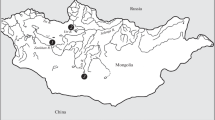Abstract
Use of traditional methods for morphological studies only permits the analysis of a small part of the information embodied in morphological structures. Besides comparing populations using the mean values of characters which allows one to estimate their morphological similarity, analysis of variation among individuals within a population can be informative. Variation among individuals consists of factorial and stochastic components. The factorial component is an upper estimate of genetic heterogeneity and thus permits one to evaluate the population's adaptability. The stochastic component (estimated by fluctuating asymmetry, i.e. random deviations from perfect bilateral symmetry), being a measure of developmental stability, is an indicator of a population's fitness. Assessment of measurement error is necessary for assessment of the true value of the stochastic component and for selection of the most informative characters. Such analysis allows one to extract additional information from morphological data in comparison with methods traditionally used on copepods. This approach was applied to an analysis of morphological variation in the study of the Baikalian endemic cyclopoid Acanthocyclops signifer (Mazepova) from three different isolated localities. Characters typically used in studies of taxonomy of this group are considered here. Measurement error was rather high (more than 50% of the stochastic component), which can be explained by technical difficulties of measuring the characters. All populations differ in the mean values of the characters. This shows the taxonomic heterogeneity of this group and reveals the necessity of its taxonomic revision. Populations also differ in the level of stochastic and factorial components of the total variance. The data are interpreted from the point of view of taxonomy and the possible evolution of the group.
Similar content being viewed by others
References
Alekseev, V. R., 1990. (Eucyclops arcanus sp. n. (Copepoda, Cyclopoida) from waterbodies of Bolshezemelskaia tundra and Prebaikalia). Zool. Z. 69: 133–139 (in Russian).
Astauroff, B. L., 1930. Analyse der erblichen Störungsfälle der bilateralen Symmetrie im Zusammenhang mit der selbstständigen Variabilität änlicher Strukturen. Zeitschrift für induktive Absammungs-und Vererbungslehre 55 (3): 183–262 (in German). See also translation into Russian: Astaurov, B. L., 1974. (Study of hereditary deviations from bilateral symmetry, associated with variation of metameric structures). In Rokitskii, P. F. (ed.), Nasledstvennost' i razvitie. Moscow: Nauka Press: 54–109.
Bazikalova, A. Y., 1945. Amfipody ozera Baikal. (Amphipoda of Baikal) Trudy Baik. Limn. Stantsii AN SSSR, v. 11. 370 pp. (in Russian).
Graham, J. H., D. C. Freeman & J. M. Emlen, 1993. Developmental stability: a sensitive indicator of populations under stress. Envir. Toxicol. and Risk Assessment, ASTMSTP 1179. In Glandis, W., J. S. Hughes & M. A. Lewis (eds), American Society for Testing and Materials, Philadelphia:. 136–158.
Hubert, W. A. & C. B. Alexander, 1995. Observer variation in counts of meristic traits affects fluctuating asymmetry. N. am. J. Fish Mgmt: 15: 156–158.
Jones, J. S., 1987. An asymmetrical view of fitness. Nature 325: 298–299.
Kozhara, A. V., 1989. On the ratio of components of phenotypic variances of bilateral characters in populations of some fishes. Genetica (USSR) 25: 1508–1513 (in Russian).
Kozhara, A. V., 1994. Phenotypic variance of bilateral characters as an indicator of genetic and environmental conditions in bream Abramis brama (L.) (Pisces, Cyprinidae) population. J. Appl. Ichth. 10: 167–181.
Lajus, D. L., 1996. What is the White Sea herring Clupea pallasi marisalbi Berg, 1923? a new concept of the population structure. In Lobon-Cerviá, J., B. Elvira & C. Granado-Lorencio (eds), Proceedings of the VIII Congress Societatis Europaea Ichtiologorum. Oviedo, Spain, Sept. 26–Oct. 2. Boel. Instit. Nac. Oceanogr. 21: 221–230.
Lajus, D. L., 1997. Is allomeric effect due to stochastic variation? J. Morph. 232: 284.
Lajus, D. L., 1998. Two-dimensional model of phenotypic variation. Proc. Zool. Inst. RAS 267: 107–114.
Mazepova, G. F., 1978. Tsiklopy ozera Baikal. (Cyclopidae of Baikal) Nauka Press. Novosibirsk. 144 pp. (in Russian).
Mazepova, G. F., 1989. Ostrakody ozera Baikal. (Ostracoda of Baikal) Nauka Press. Novosibirsk. 344 po. (in Russian).
Merilä, J. & M. Bjorklund, 1995. Fluctuating asymmetry and measurement error. Syst. Biol. 44: 97–101.
Møller, A. P., 1997. Developmental stability and fitness: a review. Am. Nat. 149: 916–932.
Møller, A. P. & J. P. Swaddle, 1997. Asymmetry, developmental stability and evolution. Oxford University Press, Oxford. 292 pp.
Monchenko, I., 1974. Tchelepnoroty tzyklopopodobni tsiklopi (Cyclopidae). Kiev 27 (3): 343 pp. (in Ukranian).
Palmer, A. R. & C. Strobeck, 1986. Fluctuating asymmetry: Measurement, analysis, patterns. Ann. Rev. Ecol. Syst. 17: 391–421.
Rice, W. R., 1989. Analysing tables of statistical tests. Evolution 43: 223–225.
Soulé, M. E., 1982. Allomeric variation. I. The theory and some consequences. Am. Nat. 120: 751–764.
Starobogatov, J. I., 1970. Fauna molluskov i zoogeograficheskoye raionirovanie kontinental'nykh vodoemov zemnogo shara. Nauka press. Leningrad 435 pp. (in Russian).
Swaddle, J. P., M. S. Witter & I. C. Cuthill, 1994. The analysis of fluctuating asymmetry. Anim. Behav. 48: 986–989.
Zakharov, V. M,. 1989. Future prospects for population phenogenetics. Sov. Sci. Rev. Sect. F, Physiol. Gen. Biol. Rev. 4: 1–79.
Author information
Authors and Affiliations
Rights and permissions
About this article
Cite this article
Lajus, D., Alekseev, V. Components of morphological variation in Baikalian endemial cyclopid Acanthocyclops signifer complex from different localities. Hydrobiologia 417, 25–35 (2000). https://doi.org/10.1023/A:1003866215089
Issue Date:
DOI: https://doi.org/10.1023/A:1003866215089




